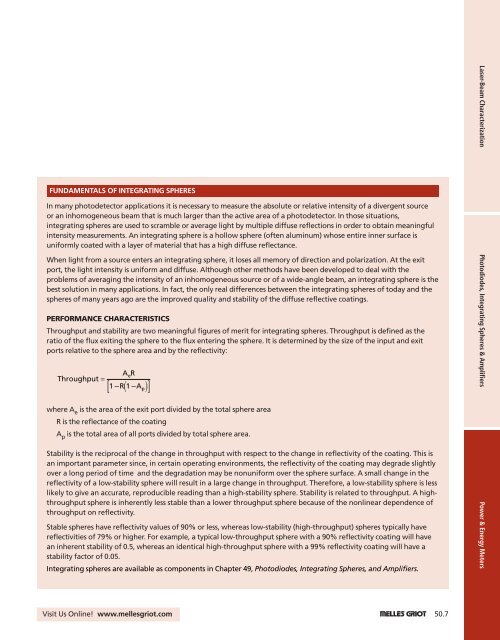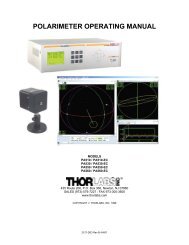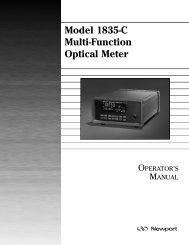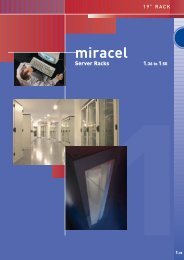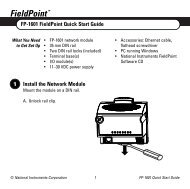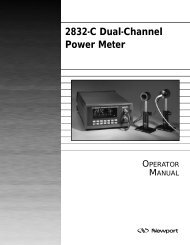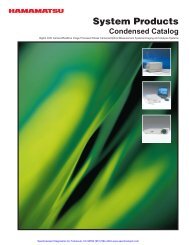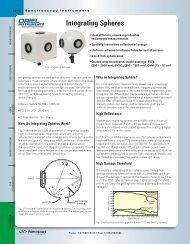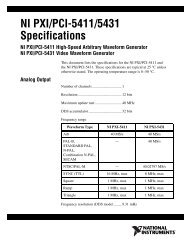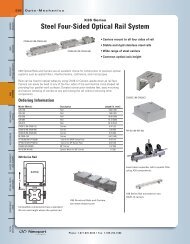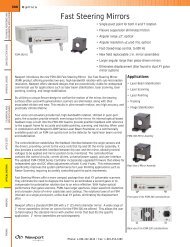Universal Optical Power Meter - Spectroscopic
Universal Optical Power Meter - Spectroscopic
Universal Optical Power Meter - Spectroscopic
You also want an ePaper? Increase the reach of your titles
YUMPU automatically turns print PDFs into web optimized ePapers that Google loves.
FUNDAMENTALS OF INTEGRATING SPHERES<br />
In many photodetector applications it is necessary to measure the absolute or relative intensity of a divergent source<br />
or an inhomogeneous beam that is much larger than the active area of a photodetector. In those situations,<br />
integrating spheres are used to scramble or average light by multiple diffuse reflections in order to obtain meaningful<br />
intensity measurements. An integrating sphere is a hollow sphere (often aluminum) whose entire inner surface is<br />
uniformly coated with a layer of material that has a high diffuse reflectance.<br />
When light from a source enters an integrating sphere, it loses all memory of direction and polarization. At the exit<br />
port, the light intensity is uniform and diffuse. Although other methods have been developed to deal with the<br />
problems of averaging the intensity of an inhomogeneous source or of a wide-angle beam, an integrating sphere is the<br />
best solution in many applications. In fact, the only real differences between the integrating spheres of today and the<br />
spheres of many years ago are the improved quality and stability of the diffuse reflective coatings.<br />
PERFORMANCE CHARACTERISTICS<br />
Throughput and stability are two meaningful figures of merit for integrating spheres. Throughput is defined as the<br />
ratio of the flux exiting the sphere to the flux entering the sphere. It is determined by the size of the input and exit<br />
ports relative to the sphere area and by the reflectivity:<br />
AR e<br />
Throughput =<br />
1 4 R1 4 A<br />
[ ( p)<br />
]<br />
where A e is the area of the exit port divided by the total sphere area<br />
R is the reflectance of the coating<br />
A p is the total area of all ports divided by total sphere area.<br />
Stability is the reciprocal of the change in throughput with respect to the change in reflectivity of the coating. This is<br />
an important parameter since, in certain operating environments, the reflectivity of the coating may degrade slightly<br />
over a long period of time and the degradation may be nonuniform over the sphere surface. A small change in the<br />
reflectivity of a low-stability sphere will result in a large change in throughput. Therefore, a low-stability sphere is less<br />
likely to give an accurate, reproducible reading than a high-stability sphere. Stability is related to throughput. A highthroughput<br />
sphere is inherently less stable than a lower throughput sphere because of the nonlinear dependence of<br />
throughput on reflectivity.<br />
Stable spheres have reflectivity values of 90% or less, whereas low-stability (high-throughput) spheres typically have<br />
reflectivities of 79% or higher. For example, a typical low-throughput sphere with a 90% reflectivity coating will have<br />
an inherent stability of 0.5, whereas an identical high-throughput sphere with a 99% reflectivity coating will have a<br />
stability factor of 0.05.<br />
Integrating spheres are available as components in Chapter 49, Photodiodes, Integrating Spheres, and Amplifiers.<br />
Laser-Beam Characterization Photodiodes, Integrating Spheres & Amplifiers <strong>Power</strong> & Energy <strong>Meter</strong>s<br />
Visit Us Online! www.mellesgriot.com 1 50.7


